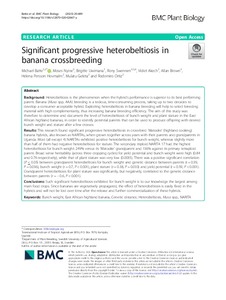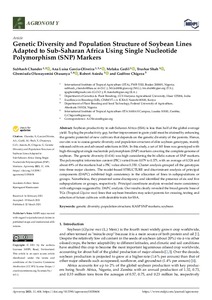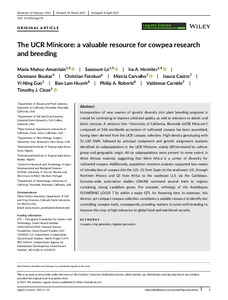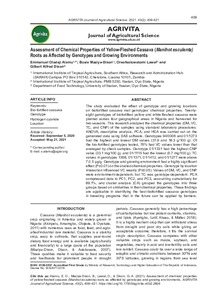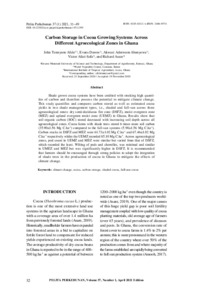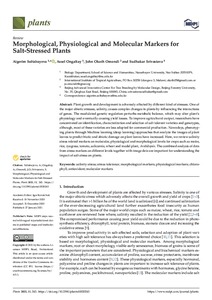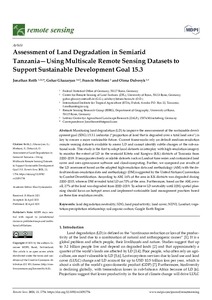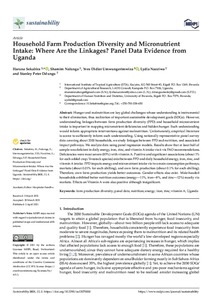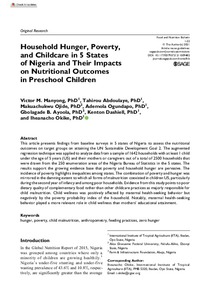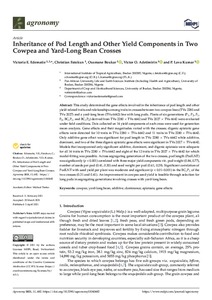Welcome to the International Institute of Tropical Agriculture Research Repository
Journal and Journal Articles: Recent submissions
Now showing items 941-960 of 5157
-
Mycotoxin profiles of solar tent-dried and open sun-dried plantain chips
(2021)Plantain is a popular dietary staple in Central and West African countries due to its versatility and excellent nutritional value. Mature unripe plantain finger is usually processed into dried chips by processors using open sun-drying method to reduce the moisture content and extends its shelf life, but without controlling the unit operations that affect product quality. Thus, this study aimed at assessing the mycotoxin profile of solar tent-dried and open sun-dried plantain chips in Nigeria. Fifty ... -
Edible crickets (Orthoptera) around the world: distribution, nutritional value, and other benefits - a review
(2021)Edible crickets are among the praised insects that are gaining recognition as human food and livestock feed with a potential of contributing to food security and reduction of malnutrition. Globally, the sustainable use of crickets as food or feed is undermined by lack of information on the number of the edible crickets, the country where they are consumed, and the developmental stages consumed. Furthermore, lack of data on their nutritional content and the potential risks to potential consumers ... -
Dataset on influence of drying variables on properties of cassava foam produced from white- and yellow-fleshed cassava varieties
(2021-08)Freshly harvested cassava has a tendency to deteriorate rapidly in its physiological properties after harvest. Therefore, cassava is often processed using a number of unit operations in order to derive a stable, storable product of acceptable eating quality. Among the unit operations employed, drying is considered as one of the oldest and most important process in arresting deterioration of cassava. In recent times, more researchers are considering foam mat drying as a drying technique for tuber ... -
Significant progressive heterobeltiosis in banana crossbreeding
(2020)Background Heterobeltiosis is the phenomenon when the hybrid’s performance is superior to its best performing parent. Banana (Musa spp. AAA) breeding is a tedious, time-consuming process, taking up to two decades to develop a consumer acceptable hybrid. Exploiting heterobeltiosis in banana breeding will help to select breeding material with high complementarity, thus increasing banana breeding efficiency. The aim of this study was therefore to determine and document the level of heterobeltiosis ... -
Digital extension, price risk, and farm performance: experimental evidence from Nigeria
(2021)Despite decades of investment in agricultural extension, technology adoption among farmers and agricultural productivity growth in Sub-Saharan Africa remain slow. Among other shortcomings, extension systems often make recommendations that do not account for price risk or spatial heterogeneity in farmers' growing conditions. However, little is known about the effectiveness of extension approaches for nutrient management that consider these issues. We analyze the impact of farmers' access to ... -
Transgenic expression of dsRNA targeting the Pentalonia nigronervosa acetylcholinesterase gene in banana and plantain reduces aphid populations
(2021)The banana aphid, Pentalonia nigronervosa, is the sole insect vector of banana bunchy top virus (BBTV), the causal agent of banana bunchy top disease. The aphid acquires and transmits BBTV while feeding on infected banana plants. RNA interference (RNAi) enables the generation of pest and disease-resistant crops; however, its effectiveness relies on the identification of pivotal gene sequences to target and silence. Acetylcholinesterase (AChE) is an essential enzyme responsible for the hydrolytic ... -
Unlocking maize crop productivity through improved management practices in northern Tanzania
(2020-12)Addressing the problem of low crop productivity and food insecurity can be accelerated through community-centered implementation of good agricultural management practices. This study was conducted in Babati, Northern Tanzania. The objective of thestudy was to determine nitrogen (N) and phosphorus (P) application requirements formaize, and demonstrate economically viable best bet yield-improving management-technologies under three ecozones namely; ‘low elevation low rainfall’, ‘medium elevation ... -
Genetic diversity and population structure of soybean lines adapted to sub-Saharan Africa using Single Nucleotide Polymorphism (SNP) markers
(2021)Soybean productivity in sub-Saharan Africa (SSA) is less than half of the global average yield. To plug the productivity gap, further improvement in grain yield must be attained by enhancing the genetic potential of new cultivars that depends on the genetic diversity of the parents. Hence, our aim was to assess genetic diversity and population structure of elite soybean genotypes, mainly released cultivars and advanced selections in SSA. In this study, a set of 165 lines was genotyped with ... -
The UCR Minicore: a valuable resource for cowpea research and breeding
(2021-06)Incorporation of new sources of genetic diversity into plant breeding programs is crucial for continuing to improve yield and quality, as well as tolerance to abiotic and biotic stresses. A minicore (the “University of California, Riverside (UCR) Minicore”) composed of 368 worldwide accessions of cultivated cowpea has been assembled, having been derived from the UCR cowpea collection. High-density genotyping with 51,128 SNPs followed by principal component and genetic assignment analyses identified ... -
Assessment of chemical properties of yellow-fleshed cassava (Manihot esculenta) roots as affected by genotypes and growing environments
(2021)The study evaluated the effect of genotype and growing locations on biofortified cassava root genotypes’ chemical properties. Twentyeight genotypes of biofortified yellow and white-fleshed cassava were planted across four geographical areas in Nigeria and harvested for two seasons. This research analyzed the chemical properties (DM, VC, TC, and CNP) of the samples using standard laboratory procedures. ANOVA, descriptive analysis, PCA, and HCA was carried out on the generated data using SAS software. ... -
Physicochemical, microbial, and aflatoxin analyses of selected high-quality cassava flour (HQCF) from the major markets of Zambia
(2021)Various quality grades of high-quality cassava flour (HQCF) are found in markets due to the rapid increase in its utilization for product development. Therefore, this study assessed the chemical, functional and pasting properties and the microbial and aflatoxin content of HQCF being sold in Lusaka markets. Nine samples of HQCF (coded CM 01 to 09) were collected from supermarkets, one major open market, and one cassava processing centre. The samples were analyzed for chemical, functional and pasting ... -
Carbon storage in cocoa growing systems across different agroecological zones in Ghana
(2021)Shade grown cocoa systems have been credited with stocking high quantities of carbon and therefore possess the potential to mitigate climate change and help achieve targets of the United Nations Collaborative Program on Reduced Emissions from Deforestation and Forest Degradation (REDD+). This study quantifies and compares carbon stored as well as estimated cocoa yields in two shade management types (i.e., shaded and full sun) across three agroecological zones: Dry Semi-Deciduous Fire Zone (DSFZ), ... -
KASPar SNP genetic map of cassava for QTL discovery of productivity traits in moderate drought stress environment in Africa
(2021)Cassava is an important staple in Sub-Sahara Africa. While its production has rapidly expanded to the dry savannahs of the continent, productivity is low in this ecology due to drought by farmers, extending the growth cycle from 12 months to 18, and sometimes 24 months to ensure better harvests. Yield is a complex trait and often difficult to manipulate for genetic gain in conventional breeding. Unfortunately, the dearth of molecular tools for decades has hampered molecular breeding (MB) to improve ... -
Morphological, physiological and molecular markers for salt-stressed plants
(2021)Plant growth and development is adversely affected by different kind of stresses. One of the major abiotic stresses, salinity, causes complex changes in plants by influencing the interactions of genes. The modulated genetic regulation perturbs metabolic balance, which may alter plant’s physiology and eventually causing yield losses. To improve agricultural output, researchers have concentrated on identification, characterization and selection of salt tolerant varieties and genotypes, although, ... -
Assessment of land degradation in semiarid Tanzania using multiscale remote sensing datasets to support sustainable development goal 15.3
(2021)Monitoring land degradation (LD) to improve the measurement of the sustainable development goal (SDG) 15.3.1 indicator (“proportion of land that is degraded over a total land area”) is key to ensure a more sustainable future. Current frameworks rely on default medium-resolution remote sensing datasets available to assess LD and cannot identify subtle changes at the sub-national scale. This study is the first to adapt local datasets in interplay with high-resolution imagery to monitor the extent ... -
Household farm production diversity and micronutrient intake: Where are the linkages? Panel data evidence from Uganda
(2021)Hunger and malnutrition are key global challenges whose understanding is instrumental to their elimination, thus realization of important sustainable development goals (SDGs). However, understanding linkages between farm production diversity (FPD) and household micronutrient intake is important in mapping micronutrient deficiencies and hidden hunger. Such understanding would inform appropriate interventions against malnutrition. Unfortunately, empirical literature is scarce to sufficiently inform ... -
Horizon scanning to assess the bioclimatic potential for the alien species Spodoptera eridania and its parasitoids after pest detection in west and central Africa
(2021)BACKGROUND The southern armyworm (SAW) Spodoptera eridania (Stoll) (Lepidoptera: Noctuidae) is native to the tropical Americas where the pest can feed on more than 100 plant species. SAW was recently detected in West and Central Africa, feeding on various crops including cassava, cotton, amaranth and tomato. The current work was carried out to predict the potential spatial distribution of SAW and four of its co-evolved parasitoids at a global scale using the maximum entropy (Maxent) algorithm. ... -
Household hunger, poverty, and childcare in 5 states of Nigeria and their impacts on nutritional outcomes in preschool children
(2021)This article presents findings from baseline surveys in 5 states of Nigeria to assess the nutritional outcomes on target groups on attaining the UN Sustainable Development Goal 2. The augmented regression technique was applied to analyze data from a sample of 1642 households with at least 1 child under the age of 5 years (U5) and their mothers or caregivers out of a total of 2500 households that were drawn from the 250 enumeration areas of the Nigeria Bureau of Statistics in the 5 states. The ... -
Inheritance of pod length and other yield components in two cowpea and yard-long bean crosses
(2021)This study determined the gene effects involved in the inheritance of pod length and other yield-related traits and relationships among traits in crosses between two cowpea lines (TVu 2280 and TVu 2027) and a yard-long bean (TVu 6642) line with long pods. Plants of six generations (P1, P2, F1, F2, BC1P1, and BC1P2) derived from TVu 2280 × TVu 6642 and TVu 2027 × TVu 6642 were evaluated under field conditions. Data collected on 14 yield components of each cross were used for generation mean analysis. ...




